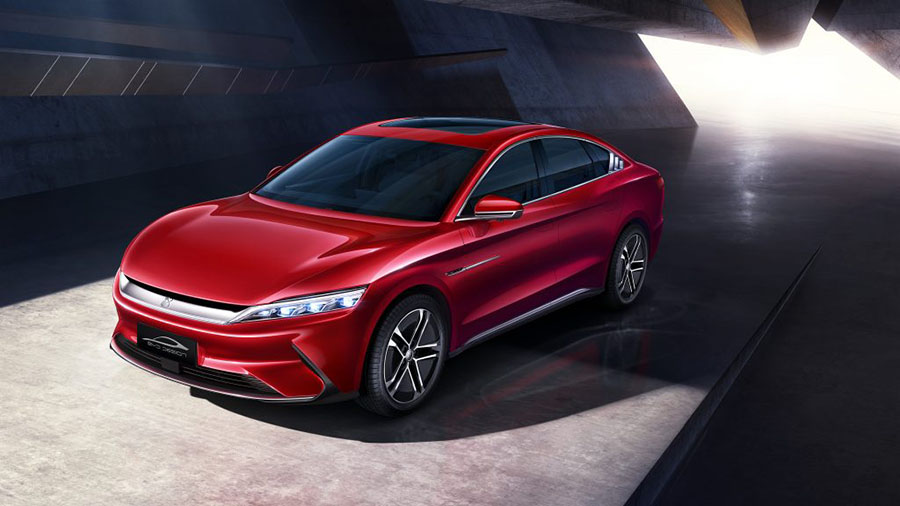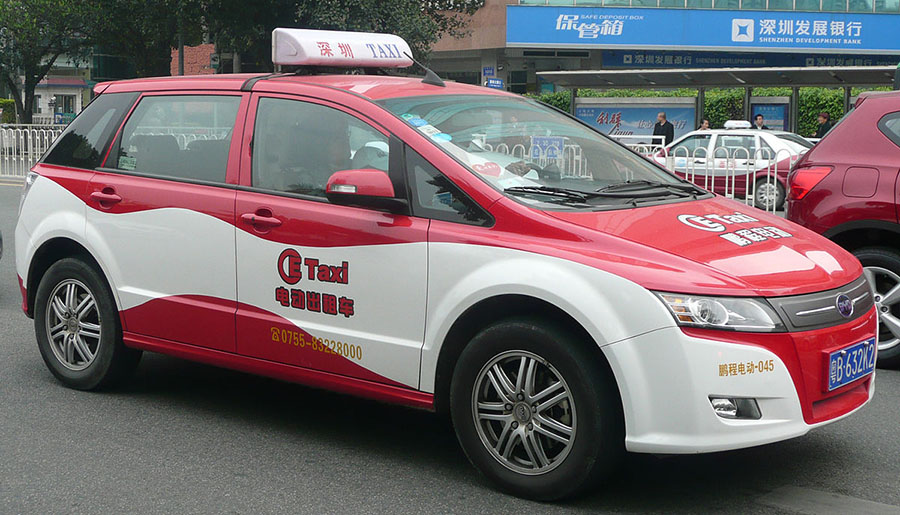BYD will soon also be offering electrically powered cars in Europe. In addition to the Tang SUV, the Han luxury limousine will also be launched.

The BYD car group plans to sell its Han electric sedan, which will be launched in its home market of China in a few weeks, in Europe as well. No specific schedule was mentioned, but a price range of 45,000 to 55,000 euros was given.
The Han EV is a four-door sedan with a high level of equipment and performance. In addition to a front-wheel drive version with 163 kW / 222 hp, there will be a 363 kW / 494 hp four-wheel drive for the almost five-meter long sedan. This should enable the sprint from a standing start to 100 km/h in less than four seconds. In addition, a new battery is used in the Han, which is said to be less susceptible to fire than other lithium-ion batteries.

The so-called blade battery should allow a range of over 600 kilometers (373 miles) in the case of the 2WD version. The sedan has the self-learning driver assistance system DiPilot, which is supposed to enable a particularly high degree of automated driving with the help of 5G networking.

BYD does not yet provide any information about the exact time and the specific countries for the start of Europe. At the beginning of May, the Chinese confirmed that this year the Tang EV600 electric SUV model would initially only be launched in Norway.
About BYD
BYD Auto Company Limited, short: BYD Auto, is a car manufacturer in Shenzhen in the province of Guangdong in the People’s Republic of China and a subsidiary of BYD Company Ltd. The company is one of the largest automobile manufacturers in China and is listed on the Hong Kong Stock Exchange. In 2015 BYD Auto was the global leader in the sale of electrically chargeable vehicles. In the field of electromobility, it is one of the most innovative companies – not least due to the market launch of the world’s first electric tractor unit , the first electric articulated bus and the first electric double-decker bus. BYD is the acronym for: Build your dreams.

History
In January 2003, the BYD specializing in the production of batteries bought the ailing state carmaker Xi’an Tsinchuan Auto Co., Ltd . This new division operates since then as a subsidiary under BYD Auto Co. Ltd.
BYD’s purchase of the state-owned company was less about acquiring technical know-how than the state license for automobile construction, which at that time was usually only granted as part of joint ventures. Initially, the production of the unsuccessful micro car was taken over and continued under the name BYD Flyer. However, the model was largely ignored with low sales.
In the following years, the company avoided the faster way of using licensed buildings from global corporations, but instead relied on in-house developments in the long term. Initially – as with other Chinese companies – there were replicas of foreign car brands in a first phase: In their own research and development centers , selected models from other manufacturers were disassembled, all patented components replaced by custom-made developments and put together again as a new model. The BYD F3, developed at the end of 2005, was a largely imitation of the Toyota Corolla and the BYD M6, which was released in 2010, looks very similar to the Toyota Previa. This approach enabled a quick learning process that led to the development of their own technology: As early as 2007, the automobile company already had more than 2,000 patents for in-house developments.
Unlike most other car manufacturers who use products from the supplier industry, BYD Auto produces most of the components itself; In addition to engines, gearboxes, control and braking systems and all vehicle electronics, this includes windshield wipers, seat belts, airbags and CD players (only tires, car glass and a few general components are procured externally.)
On March 10, 2010 BYD Auto acquired the Japanese company Ogihara Corp. to improve the further independence from suppliers and to achieve a largely self-sufficient production process. At the same time, BYD Auto was continuously expanding its research and development centers, where around 10,000 engineers now work at four locations.
In a second phase, this promoted the transition to completely new developments. The result was new vehicles, such as the BYD F3DM as the first hybrid vehicle in China, the successor model BYD Qin and the BYD e6 , an electric car that is mainly used as a taxi worldwide.
In 2010 over 500,000 vehicles were already produced.
The globally marketed BYD ebus is also used in regular service in Europe, for example in the Netherlands (35 buses in Amsterdam-Schiphol) and in London (two lines with 51 battery buses). BYD Auto is the largest electric bus fleet in Europe. A total of 50,000 electric buses were manufactured by January 2019.
In a report on the future of the automotive industry, the Office for Technology Assessment at the German Bundestag confirmed BYD Auto a high degree of integration and a high level of added value in the area of battery manufacture required for electric vehicles.
On March 29, 2012, the company received a safety certificate from TÜV Rheinland for the charging devices of its BYD ebus and BYD e6 electric vehicles , which simplifies the targeted marketing of these products on the European and American markets.
In the same year, BYD expanded its business to include the production of forklifts. A factory with production capacities for 50,000 vehicles per year was built on a newly developed site in the Shaoguan industrial park on 100,000 m2. In 2016 the company received the “World’s Best Truck of the Year” award from the IFOY Award, sponsored by the Federal Ministry for Economic Affairs and Energy , at the leading trade fair CeMAT in Hanover.
2014, the company expanded its range of electric vehicles to electric truck T5 and T7, and the world’s first electric tractor T9. BYD electric trucks have been used in large numbers since September 2016 as street cleaning trucks in the Chinese capital Beijing.
Companies in the field of battery technology have an innovative advantage in the development of new electric vehicles compared to traditional automotive companies, which tend to stick to the improvement of the conventional internal combustion engine and the drive train (not available for electric vehicles). In the first half of 2016, the company multiplied its profit by 384%.

At the beginning of May 2020, the company announced that it would boost its vehicles offerings in Europe in 2020. The BYD Tang is to be launched on the Norwegian market, which is one of the world’s leading electric cars market.
BYD Production sites
BYD Auto has eight production sites worldwide: Xi’an, Shangluo, Shaoguan, Shenzhen, Lancaster (California), Sriperumbudur, Komárom and Allonne. Electric trucks and the BYD ebus are manufactured in the city of Lancaster, California. Together with the company Alexander Dennis, electric buses will be in the Scottish city of Falkirk for the British market. In spring 2017, the company’s first automobile factory on the European continent was opened in the Hungarian city of Komárom. Initially, an annual assembly of 200 electric buses and electric forklifts is planned. After expansion, electric trucks will also be manufactured for the European market. The plant is operated as a subsidiary under the name BYD Electric Bus & Truck Hungary Kft.
BYD Green City Solution
The Green City Solution concept, developed by the company, is a plan to electrify local transport in cities. The previously used buses and taxis (with diesel or petrol engines) are to be replaced by purely electric vehicles ( BYD e6 and BYD ebus ). Thanks to this concept, BYD took 8th place in a ranking of the Boston Consulting Group in 2010, in which the most innovative companies in the world were honored.

Chinese cities are polluted with considerable air pollution, which is also caused by the growing motorization. According to the concept, there are over 30 million passenger cars in China today, including around 1.2 million taxis and around 500,000 buses. The company therefore sees great savings potential in these vehicles in terms of fuel consumption and the emissions produced. Replacing all taxis and buses in China with electric vehicles would (according to this concept) have the same effect as converting 27 million conventional passenger cars with combustion engines to electric cars.

The Green City Solution concept not only aims to reduce CO2 emissions through the use of electric vehicles, but also, the electricity required is to be generated by solar and wind power plants (of the company), stored in BYD battery storage power plants and transmitted to a network of charging stations to be built in the cities. The Group’s study assumes that these measures will reduce both urban pollution and the operating costs of buses and taxis by around a third.
Green City Solution is part of a government-led modernization campaign aimed at replacing city buses powered by diesel engines with electric buses. Industry experts assume an annual domestic demand of 50,000 to 150,000 vehicles of this type. In 2009, the government also adopted a subsidized economic plan to make the People’s Republic the global market leader in electric buses.









